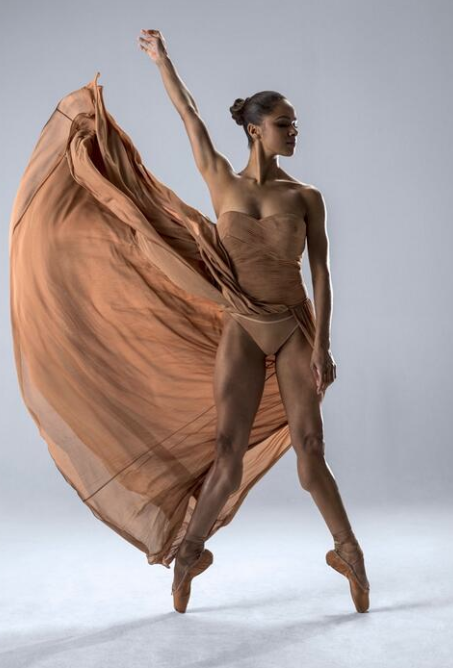Misty Copeland made history Tuesday, becoming the first African-American female principal dancer at New York’s American Ballet Theatre.
Ballet Theatre’s artistic director Kevin McKenzie announced her promotion to principal from soloist today, a move that expands racial diversity within the elite ranks of ballet—and ends months of speculation.
Promotions are always closely watched in the ballet world, and today’s announcement includes the elevation of Stella Abrera to principal, as well as the naming of several new soloists.
Ms. Copeland, 32 years old, has had a career-defining season at the Metropolitan Opera House this spring. In June, she made her New York debut as the lead in “Swan Lake” and a career debut in “Romeo and Juliet.” In both, she exhibited clear artistic choices and compelling dramatic presence.
She has drawn praise for her ability to shine in both classical and contemporary ballets. In Alexei Ratmansky’s 2012 “Firebird,” she made the role her own, dancing with attack and intensity, inspiring Wall Street Journal critic Robert Greskovic to call the performance “steely.”
“She has a beautiful feeling for contemporary work,” said Susan Jaffe, a former principal at Ballet Theatre. “She’s got such an extraordinary facility.”
Ms. Copeland’s appeal has far transcended the dance world.
Her story of rising from poverty to ballet’s highest echelon captivated a wide audience that encountered her not only onstage but via her best-selling memoir, active social-media presence and a 2014 advertisement for the Under Armour sportswear brand that garnered more than 8 million views on YouTube.
What Ms. Copeland’s success means for diversity in ballet, though, is a matter of some skepticism for longtime participants and observers of dance, who see the milestone as one marker on a long road that the industry needs to travel.
“There are severe racial inequities in dance, as in society at large,” said Lane Harwell, Executive Director of Dance/NYC, an industry trade group.
Those inequities can be addressed, said Apollo Theater executive producer Mikki Shepard. But it requires having more artistic leaders who make diversity a priority, as well as nurturing environments and a pipeline of opportunity for dancers of color.
“It’s not any one challenge. It is many challenges,” said Ms. Shepard, adding that this is a long-running topic. “These were conversations that were started in the ’60s.”
At that time, she said, the issues were focused on the creation of new institutions to support and expand opportunity for dancers of color, such as Dance Theater of Harlem, founded in 1969 by former New York City Ballet Arthur Mitchell and Karel Shook.
“It came out of the civil-rights movement,” said Ms. Shepard. “In the 1980s, it was an interest in supporting diversity in audience, staffs and boards.”
Ms. Copeland’s popularity has demonstrated—to anyone who has watched multiple casts at Ballet Theatre—that there is a direct link between breaking a color barrier onstage and drawing a broad audience.
“When she’s on, the audience is totally diverse,” said Judith Jamison, artistic director emerita of Alvin Ailey American Dance Theater. “This is what happens when you give people opportunity to do things they are capable of doing.”
In dance, as in other art forms and most sports, stars inspire the participation of future generations. A supernova like Ms. Copeland can undoubtedly send curious children to ballet class, but keeping them there can be a cultural and financial challenge.
Understanding that, Ballet Theatre launched the Project Plié initiative in 2013 to expand the demographic of children who have access to ballet class. Working with American regional ballet companies and the Boys & Girls Clubs of America, Project Plié is intended to funnel dancers of color to classes locally, in the hopes that some will seek to study professionally.
Ms. Copeland, who found her way to ballet through a Boys & Girls Club, is on the Project Plié advisory committee and her example sets a standard. At 13, a late age for dancers, she began studying at the San Pedro City Ballet in California, later attending Ballet Theatre’s summer classes. Ms. Copeland joined Ballet Theatre’s junior company in 2000, then the main company’s corps de ballet, or ensemble, in 2001. In 2007, she was promoted to soloist.
Source: Wall Street Journal
















































































































































































































































![[Video] Chicago Police Officers Caught On Video Telling Two Black Men "We Kill Mother F**kers"](https://earhustle411.com/wp-content/uploads/2018/07/evil-cop-3-300x180.jpg)
![[Video] Chicago Police Officers Caught On Video Telling Two Black Men "We Kill Mother F**kers"](https://earhustle411.com/wp-content/uploads/2018/07/evil-cop-3-80x80.jpg)












![[Video] White Woman Calls The Cops On Black Real Estate Investor, Cops Threaten To Arrest Her For Harassing Him](https://earhustle411.com/wp-content/uploads/2018/05/nosy-neighbor-300x180.png)
![[Video] White Woman Calls The Cops On Black Real Estate Investor, Cops Threaten To Arrest Her For Harassing Him](https://earhustle411.com/wp-content/uploads/2018/05/nosy-neighbor-80x80.png)


![White Scientist Says The Black Community Is Being Targeted By The Medical System, They Are Deliberatly Being Poisoned [Video]](https://earhustle411.com/wp-content/uploads/2016/05/mike-adams-300x180.jpg)
![White Scientist Says The Black Community Is Being Targeted By The Medical System, They Are Deliberatly Being Poisoned [Video]](https://earhustle411.com/wp-content/uploads/2016/05/mike-adams-80x80.jpg)








![Teenage Girl Shot In Her Stomach Three Times But Took Time To Post To Facebook [ Video]](https://earhustle411.com/wp-content/uploads/2016/02/Gangster-chick-300x180.jpg)
![Teenage Girl Shot In Her Stomach Three Times But Took Time To Post To Facebook [ Video]](https://earhustle411.com/wp-content/uploads/2016/02/Gangster-chick-80x80.jpg)








Pingback: Ballerina Misty Copeland Reveals Her Own Barbie Doll | Ear Hustle 411